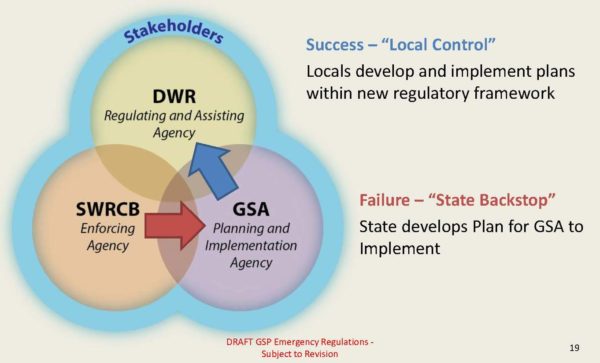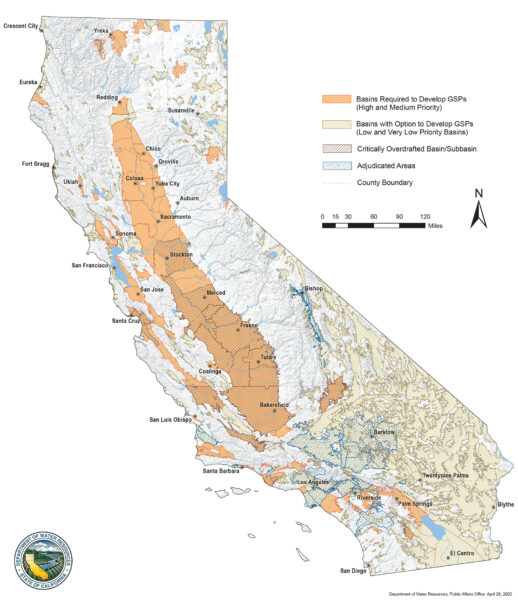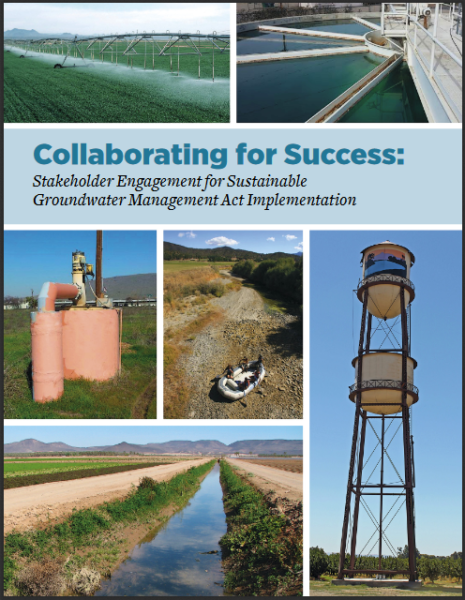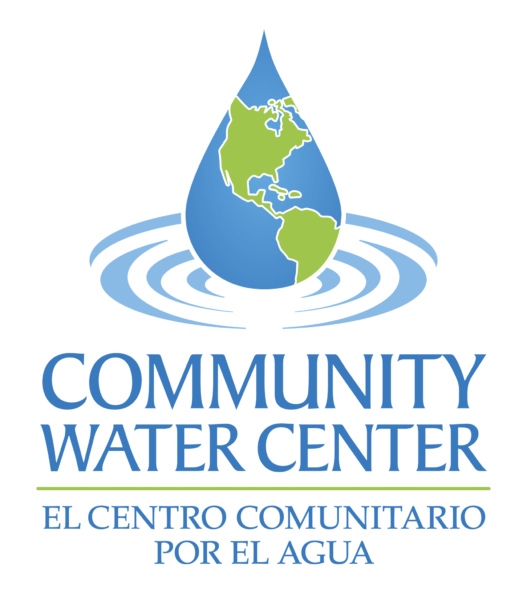Para leer esta página en español, haga clic aquí.
For a selection of introductory videos on SGMA, click here.
California depends on groundwater for a major portion of its annual water supply, making sustainable groundwater management essential to a reliable and resilient water system. In recognition of this, in September 2014, Governor Brown signed a three-bill package of legislation into law collectively known as the Sustainable Groundwater Management Act (SGMA).
Sustainable groundwater management under SGMA singles out six “undesirable results” to be avoided:
-
-
- Chronic lowering of groundwater levels indicating a significant and unreasonable depletion of supply
- Significant and unreasonable reduction of groundwater storage
- Significant and unreasonable seawater intrusion
- Significant and unreasonable degradation of water quality
- Significant and unreasonable land subsidence
- Groundwater-related surface water depletions that have significant and unreasonable adverse impacts on beneficial uses of surface water
-
At the center of the legislation is the decision that groundwater management is best accomplished at the local level. Under SGMA, Groundwater Sustainability Agencies are tasked with developing and implementing locally-developed Groundwater Sustainability Plans for all groundwater basins designated as medium or high priority by the Department of Water Resources. The legislation allows 20 years to achieve sustainability.
The Sustainable Groundwater Management Act (SGMA) is less a change in the rules governing the use of groundwater and more an introduction of rules where previously there were none. Until SGMA was passed in 2014, the use of groundwater throughout the state was largely unregulated. Anyone could apply for a well drilling permit from their county and drill and use a well on their property as they saw fit.
Among the problems with this approach is that the aquifers are natural formations, not restricted by property lines or political boundaries. We all share the water beneath our feet. What a city or individual does in one area can have a big impact on people living 10, 30 and even 100 miles away. If everyone extracts as much groundwater as they please, without regard for the cumulative impact of all users combined, we could find ourselves with no access to groundwater, and no way to meet our household, municipal, agricultural or industrial needs.
In order to protect this shared resource, it is therefore critical that groundwater users share and coordinate their activities. SGMA was passed to facilitate protection of the resource for all users .
*Text from Community Water Center’s SGMA Frequently Asked Questions.
-
-
- Protection of water rights: Existing water rights are protected. Nothing in it “determines or alters surface water rights or groundwater rights under common law or any provisions of law that determines or grants surface water rights”.
- Consideration of multiple stakeholder interests: The legislation requires that a Groundwater Sustainability Agency must consider and conduct outreach to a broad range of stakeholders, such as beneficial users of water, environmental interests, disadvantaged communities, tribes, and others.
- Provides new authorities to Groundwater Sustainability Agencies to manage groundwater: Groundwater Sustainability Agencies are granted new tools and authorities for Groundwater Sustainability Agencies which include the authority to conduct investigations, determine the sustainable yield of a basin, measure and limit groundwater extractions, impose fees for groundwater management, and enforce the terms of a groundwater sustainability plan.
- Increases coordination between land use planning agencies and Groundwater Sustainability Agencies: Planning and zoning laws are amended to require increased coordination between land use planning agencies and groundwater sustainability agencies regarding groundwater plans and updates and modifications of General Plans.
- Increases availability of information while ensuring privacy protection: The legislation requires aggregated groundwater information for a groundwater basin be provided to the Department of Water Resources; however, information related to individual groundwater pumpers is limited.
- State oversight and involvement: The legislation allows for intervention by the State Water Board instances where the Groundwater Sustainability Agency does not complete a groundwater sustainability plan by the mandated deadline (2020 or 2022); the Groundwater Sustainability Plan is deemed inadequate by the Department of Water Resources and the deficiencies remain inadequately addressed; or the groundwater sustainability plan is being implemented and simply does not work. In these cases, the State Water Board is authorized to create an interim plan that will remain in place until the GSA is able to reassume responsibility.
- Protection of water rights: Existing water rights are protected. Nothing in it “determines or alters surface water rights or groundwater rights under common law or any provisions of law that determines or grants surface water rights”.
-
 SGMA defined new roles for agencies.
SGMA defined new roles for agencies.
For local agencies, SGMA requires local groundwater pumpers to form Groundwater Sustainability Agencies (or GSAs) and to develop Groundwater Sustainability Plans to manage their groundwater basins. In order to effectively implement those plans, SGMA provides new tools and authorities including requiring registration of groundwater wells, measuring and limiting groundwater extractions, imposing fees for groundwater management, and enforcing the terms of a groundwater sustainability plan.
SGMA tasked the Department of Water Resources with developing regulations to revise groundwater basin boundaries; adopting regulations for evaluating and implementing Groundwater Sustainability Plans and coordination agreements; identifying basins subject to critical conditions of overdraft; identifying water available for groundwater replenishment; and publishing best management practices for the sustainable management of groundwater. DWR is also tasked with evaluating groundwater sustainability plans for adequacy.
For enforcement purposes, the legislation allows for intervention by the State Water Board in instances where the groundwater sustainability agency does not complete a plan by the mandated deadline of 2020 or 2022; the plan is deemed inadequate by DWR and remains so after efforts to cure the deficiencies; or the plan is being implemented and simply does not work.
 All groundwater basins designated as medium or high priority by the Department of Water Resources are required to form Groundwater Sustainability Agencies to develop and implement locally-developed groundwater sustainability plans. Those basins are shown in orange on the map to the right.
All groundwater basins designated as medium or high priority by the Department of Water Resources are required to form Groundwater Sustainability Agencies to develop and implement locally-developed groundwater sustainability plans. Those basins are shown in orange on the map to the right.
A basin’s prioritization is based on several factors, such as population and rate of growth, irrigated acreage, and the degree to which the overlying population is dependent on groundwater as their primary source of water. These factors are then totaled and then the basins ranked as high, medium, low, or very-low priority. Those basins which are ranked as high or medium priority are subject to SGMA – meaning they must form GSAs and develop GSPs.
Three important things to note:
1. The designation of high or medium priority does not mean the basin is not being managed well. It means that the groundwater basin scored high on factors that indicate that the basin is an important and critical source for the overlying cities and farms. Many high priority groundwater basins are well-managed.
2. The basin prioritization will change when basin boundaries are modified because changing boundaries changes the factors that go into determining the ranking.
3. In terms of SGMA, there is no real difference between high and medium priority basins; both are subject to the provisions of SGMA.Not all groundwater basins are required to establish Groundwater Sustainability Agencies and develop Groundwater Sustainability Plans, although other requirements may apply.
Specifically excluded from SGMA are:
-
-
- Low and very low priority basins: Basins designated as low and very-low priority are not subject to SGMA, but are encouraged to form Groundwater Sustainability Agencies and develop new groundwater management plans or update existing management plans in accordance with the water code. Click here for more information on developing a groundwater management plan.
- Adjudicated basins: Basins managed under a court ruling that stipulates the groundwater rights of all the overliers and appropriators, or basins with adjudications underway at the time that SGMA was enacted, are not required to form Groundwater Sustainability Agencies or develop Groundwater Sustainability Plans; however, SGMA requires adjudicated basins to file annual reports with the Department of Water Resources. Click here for more information.
- ‘Fringe’ or unmanaged areas outside of adjudications: The area subject to the adjudication is determined by the court; oftentimes, those adjudicated areas do not entirely match the geologic boundary of a basin, creating unmanaged areas within a basin. Groundwater pumpers in unmanaged areas are required by SGMA are required to file groundwater extraction reports with the State Water Resources Control Board. For more information, click here.
- Low and very low priority basins: Basins designated as low and very-low priority are not subject to SGMA, but are encouraged to form Groundwater Sustainability Agencies and develop new groundwater management plans or update existing management plans in accordance with the water code. Click here for more information on developing a groundwater management plan.
-
-
-
- January 31, 2020: Groundwater Sustainability Plans must be adopted for those basins designated as critically overdrafted.
- January 31, 2022: Groundwater Sustainability Plans must be adopted for all other remaining groundwater basins designated as high and medium priority.
- 2040/2042: All groundwater basins designated as high or medium priority must attain sustainability.
-
In June of 2018, the Department of Water Resources issued a draft SGMA Basin Prioritization report, after modifications of basin boundaries for some basins were approved. The adjustment to the boundaries of some groundwater basins has resulted in some basins becoming low or very-low priority while other basins have become medium or high priority.
Those basins whose designations have changed from low or very-low priority to medium or high priority will have two years from the date the reprioritization is finalized to either establish a Groundwater Sustainability Agency (or agencies), or submit an alternative plan. Five years are allowed to develop and submit a Groundwater Sustainability Plan to DWR for review.
SGMA requires that all groundwater basins designated as high or medium priority establish Groundwater Sustainability Agencies to manage their groundwater basin.
Any public agency with water or land use responsibilities can be a Groundwater Sustainability Agency; these include cities, counties, municipal water districts, irrigation districts, community services districts, resource conservation districts, and water conservation districts.
In its simplest form, a groundwater basin can be managed by a single Groundwater Sustainability Agency that develops a single Groundwater Sustainability Plan. However, some groundwater basins have more than one Groundwater Sustainability Agency; those agencies can choose to develop a single Groundwater Sustainability Plan, or to develop multiple plans that are coordinated by an agreement that covers the entire basin.
Sustainable groundwater management is defined as the management and use of groundwater that can be maintained without causing an undesirable result.
-
-
- Undesirable results as defined in SGMA are:
- Persistent lowering of groundwater levels
- Significant and unreasonable reductions in groundwater storage
- Significant and unreasonable saltwater intrusion
- Significant and unreasonable degradation of water quality
- Significant and unreasonable land subsidence
- Surface water depletion having significant and unreasonable effects on beneficial uses
-
What is considered “significant and unreasonable” is left for the local GSAs and stakeholders to decide.
The Act requires that a Groundwater Sustainability Agency prepare a Groundwater Sustainability Plan that lays out the path that the basin will take to achieve sustainable groundwater management within 20 years.
SGMA establishes a broad framework for local agencies to manage groundwater, giving local agencies some flexibility about how to achieve sustainability, as well as how sustainability is defined in the local context.
Groundwater Sustainability Plans have several requirements, including:
-
-
- A description of the physical setting and characteristics of the aquifer system.
- Current and historical data for groundwater levels, groundwater quality, subsidence, and groundwater-surface water interaction, and a discussion of historical and projected water demands and supplies.
- Maps that include details of the basin and its boundaries and identify existing and potential recharge areas
- A succinctly stated sustainability goal for a desired condition that is applicable to the entire basin, how the basin will get to that desired condition, and why the measures planned will lead to success.
- Measurable objectives, as well as interim milestones in increments of five years, to achieve the sustainability goal in the basin within 20 years
- A monitoring plan that will measure progress over time
- A description of other applicable local government plans and how the GSP may affect those plans
-
SGMA also established a process for local agencies to develop an Alternative in lieu of a Groundwater Sustainability Plan, provided the alternative is functionally equivalent to the elements of a Groundwater Sustainability Plan.
After a Groundwater Sustainability Plan is adopted, it is then submitted to the Department of Water Resources who has two years to review the plan for adequacy. If it is found inadequate, GSAs will be given six months to provide remedies.
If the Department of Water Resources determines that the Groundwater Sustainability Plan is inadequate and the Groundwater Sustainability Agency does not or cannot correct the deficiencies, the State Water Board can designate the basin as “probationary”. If the local agency does not respond within 180 days, the State Water Board is authorized to step in and assume management of the basin until the GSA is able to reassume management with a compliant plan.
If the State Water Board intervenes in the management of a groundwater basin, the Board must assess fees to recover the cost incurred in administering a probationary basin, such as reporting requirements, investigations, facilitation, monitoring, hearing, enforcement, and administrative costs.
For more information on State Water Board intervention, click here.
Do you have a groundwater well that serves your household? Generally, domestic well users meet the SGMA definition of a de minimis extractor, defined as “a person who extracts, for domestic purposes, two acre-feet or less (of groundwater) per year.” Most households with a domestic well that are not watering crops or large areas of landscape are likely de minimis extractors; however, under certain circumstances, SGMA may apply.
Whether or not SGMA applies to a domestic well owner, the implementation of a Groundwater Sustainability Plan will mean changes in the management of groundwater with potentially wide-ranging effects. All stakeholders in a groundwater basin subject to SGMA are encouraged to participate in the development of a Groundwater Sustainability Plan to ensure a robust and successful outcome.
For more information:
SGMA sets a new course for groundwater in California that will fundamentally change how groundwater is managed. Ultimately, GSAs will be responsible for deciding who can pump how much and what fees will be charged in order to maintain sustainable groundwater basins through both wet and dry years; these decisions are likely to have far-reaching consequences for local communities and the region.
All GSAs are legally required to consider all beneficial uses and users of groundwater, including domestic, agricultural, municipal, environmental, tribes, and disadvantaged communities; it is critical that local water users participate in the process to ensure the management changes address the diverse needs and priorities of the region. A Groundwater Sustainability Plan developed through robust involvement with all stakeholders within the basin will ensure the Plan’s success.
To participate in your area:
-
-
- Determine your groundwater basin. Click here to find your basin page.
- Determine which GSA you live in (this will be listed on your basin’s page.)
- Put your name on the Interested Persons List to receive automatic notifications of meetings and opportunities to engage in the process.
- Attend meetings and workshops and provide your comments and input. Take advantage of opportunities to serve on a stakeholder or technical advisory committee.
-
For more information on SGMA and participating in groundwater management:
Key publications and resources
Stakeholder Communication and Engagement (DWR)
Examples and resources to engage stakeholders in Groundwater Sustainability Plan (GSP) preparation.
[pdf-embedder url=”https://f0b.362.mwp.accessdomain.com/wp-content/uploads/2020/02/DWR-Stakeholder-Communication-and-Engagement.pdf” title=”DWR Stakeholder-Communication-and-Engagement”]Getting involved in groundwater: A guide to Groundwater Sustainability Plans
This guide helps stakeholders get involved in developing a local groundwater sustainability plan.
[pdf-embedder url=”https://f0b.362.mwp.accessdomain.com/wp-content/uploads/2020/03/Getting_Involved_in_Groundwater_Toolkit.pdf”]Collaborating for Success: Stakeholder Engagement for Sustainable Groundwater Management Act Implementation
 The results of stakeholder engagement strongly depend on the nature of the engagement process. Therefore, the manner in which SGMA’s engagement and participation requirements are incorporated into the process will ultimately determine the degree to which these efforts further the goal of achieving sustainable groundwater management.
The results of stakeholder engagement strongly depend on the nature of the engagement process. Therefore, the manner in which SGMA’s engagement and participation requirements are incorporated into the process will ultimately determine the degree to which these efforts further the goal of achieving sustainable groundwater management.
For local agencies and, later, Groundwater Sustainability Agencies to maximize the impact of stakeholder engagement, engagement needs to be institutionalized so that stakeholder contributions tangibly shape outcomes. Additionally, the level of and mechanisms for engagement need to be suited to the needs, desires, and interests of the stakeholders.
The intent of this paper is to convey the value of stakeholder engagement to sustainable groundwater management and to provide tools that will help maximize its benefits. Section One considers the question, what is stakeholder engagement and why is it important? Section Two then outlines the statutory requirements for stakeholder engagement in SGMA. Finally, Section Three, drawing on best practices and examples of collaborative management from around the state, provides a recommended roadmap for effective stakeholder engagement drawn specifically for SGMA implementation.
Click here to download this document from Clean Water Action.
State Water Board Fact Sheet: Stakeholder Inclusion
[pdf-embedder url=”https://f0b.362.mwp.accessdomain.com/wp-content/uploads/2020/08/sgma_stkhldr.pdf”]Engagement with tribal governments
Resources for GSAs to engage California’s Tribal governments, including those on Tribal lands not subject to SGMA.
[pdf-embedder url=”https://f0b.362.mwp.accessdomain.com/wp-content/uploads/2020/02/Guidance_Document_Tribal_Governments.pdf”]The Groundwater Game
 The Groundwater Game provides players with an interactive opportunity to experience the challenges of managing increasingly scarce groundwater when there are competing needs. The game also provides players with a greater understanding of different management tools, including groundwater trading.
The Groundwater Game provides players with an interactive opportunity to experience the challenges of managing increasingly scarce groundwater when there are competing needs. The game also provides players with a greater understanding of different management tools, including groundwater trading.
[pdf-embedder url=”https://f0b.362.mwp.accessdomain.com/wp-content/uploads/2018/07/GSP-Regulations-Stakeholder-Outreach.pdf” title=”GSP Regulations Stakeholder Outreach”]
Publicaciones clave en español
Documento Guia para el GSP – Comunicacion y Participacion de los Interesados
Este documento guía ofrece a las agencias de Sostenibilidad del Agua Subterránea (GSA) información útil para la comunicación y participación de los interesados en la elaboración del Plan de Sostenibilidad del Agua Subterránea (GSP).
[pdf-embedder url=”https://f0b.362.mwp.accessdomain.com/wp-content/uploads/2020/03/Guidance_Document_for_Groundwater_Sustainability_Plan__Stakeholder_Communication_and_Engagement__Spa.pdf”]Guía para entender los planes de sustentabilidad de aguas subterráneas de California
Esta guía está diseñada para ayudarle involucrarse en el desarrollo de un plan local de sustentabilidad de agua subterránea, que requiere la Ley de Manejo Sustentable de Aguas Subterráneas de California.
[pdf-embedder url=”https://f0b.362.mwp.accessdomain.com/wp-content/uploads/2020/09/Participe_en_el_Manejo_de_su_Cuenca.pdf”]Un folleto que explica los conceptos básicos de la Ley de gestión Sustentable del Agua Subterránea (SGMA).
[pdf-embedder url=”https://f0b.362.mwp.accessdomain.com/wp-content/uploads/2020/03/SGMA_Interagency_Brochure_-_Spanish_Version_1.pdf”]Organizations active in SGMA outreach
 Community Water Center
Community Water Center
The Community Water Center is a catalyst for community-driven water solutions through organizing, education, and advocacy in California. They work to build strategic grassroots capacity to address water challenges in small, rural, low-income communities and communities of color. Visit the Community Water Center online by clicking here.
 Self Help Enterprises
Self Help Enterprises
Self-Help Enterprises is providing a multi-disciplinary technical assistance program to assist severely disadvantaged communities (SDACs) to engage in groundwater sustainability planning to become viable partners in regional groundwater projects. Learn more online at Self Help Enterprises.
